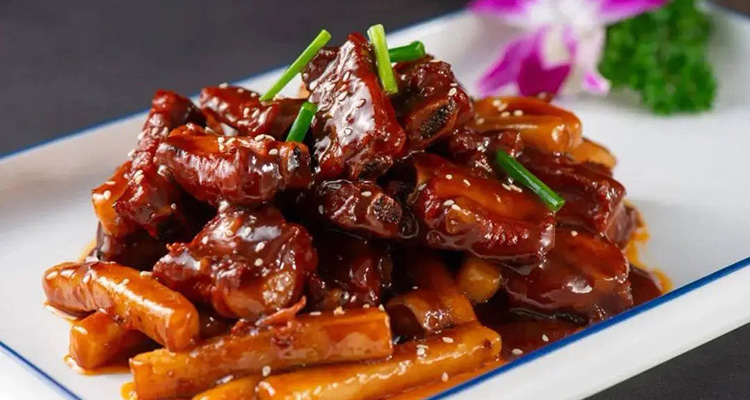Shanghai Pork-Rib Rice Cake: Crispy Ribs & Chewy Rice Cakes Street Food Guide
1. Origin in Shanghai: A Mid‑Century Street Classic
The Shanghai Pork‑Rib Rice Cake dates back to the 1950s. In a time of limited resources, inventive local cooks combined northern pork ribs with southern rice cakes to create an affordable, flavorful street snack. Two famous shops, Xian De Lai and Xiao Changzhou, represent the dish’s iconic styles and helped make it a staple of Shanghainese cuisine.
2. Two Classic Methods: Xian De Lai vs. Xiao Changzhou
Xian De Lai emphasizes a crisp exterior and tender interior. Ribs are coated in a batter of wheat flour, arrowroot starch, five‑spice powder, and egg, then deep‑fried until golden. Songjiang rice cakes are cooked with light soy sauce, sweet bean paste, and chili sauce, absorbing flavors to create a chewy, sweet‑and‑spicy bite.
Xiao Changzhou highlights premium ingredients’ natural flavor. Pork spine meat from Changzhou and Wuxi is marinated in soy sauce, blanched in a sauce of soy, oil, sugar, scallions, ginger, and Shaoxing wine. Steamed Songjiang rice is pounded and cut into strips, wrapped around ribs, and simmered in sauce. A dusting of five‑spice powder completes the dish.

3. A Harmony of Textures and Flavors
Authentic Shanghai Pork‑Rib Rice Cake is a textural duet: crispy ribs lock in juicy meat, while rice cakes soak up savory sauce and become soft and springy. Sweet bean paste adds gentle sweetness, chili provides mild heat, and five‑spice enhances aromatic depth. The combination is savory, slightly sweet, crispy yet chewy — a true taste of classic Shanghainese cooking.
4. How to Eat It: Tips for the Full Local Experience
For a true local experience, bite both rib and rice cake together to enjoy the contrast of crisp and glutinous textures. Vendors often offer sweet bean paste and chili sauce to adjust flavor. Pair with a light wonton soup or mung bean soup for balance. Always eat hot to appreciate the crispy crust and saucy rice cakes.

5. Where to Try It: Old Brands and Street Stalls
Seek out iconic shops like Xian De Lai and Xiao Changzhou in central districts such as Huangpu. A serving costs around 20–30 RMB. Avoid peak hours to skip long queues. Food streets like Yunnan South Road and Huanghe Road also offer authentic stalls serving delicious pork‑rib rice cakes.
6. Try It at Home: A Simple Recipe
A home version is simple:
- Tenderize pork ribs and marinate 30 minutes in soy, cooking wine, sugar, and five‑spice powder.
- Blanch rice cake slices.
- Mix flour, starch, and egg into a batter, coat ribs, and deep‑fry at 180°C until golden.
- Simmer fried ribs and rice cakes briefly with soy, sugar, and water.
- Finish with sweet bean paste, chili sauce, and chopped scallions.
7. Cultural Imprint: More Than a Snack
Pork‑Rib Rice Cake is a culinary memento of Shanghai’s 20th‑century history. It reflects the city’s fusion of northern and southern flavors, the resourcefulness of generations of cooks, and Shanghai’s identity as a cosmopolitan port. Today, it remains a tasty reminder of local memory and urban change.

8. Flavor Profile: Sweet, Savory, and Crispy
The dish combines layers of flavor and texture: crispy ribs, chewy rice cakes, mild sweetness, aromatic five‑spice, and a hint of chili. This balance is a hallmark of classic Shanghainese street food.
9. Summary & Call to Action
Whether shopping on Nanjing Road or exploring historic alleys, don’t miss this 50‑year-old Shanghai Pork‑Rib Rice Cake. Let the crispy ribs and soft rice cakes tell the city’s story — a must-try for every culinary traveler in Shanghai.


